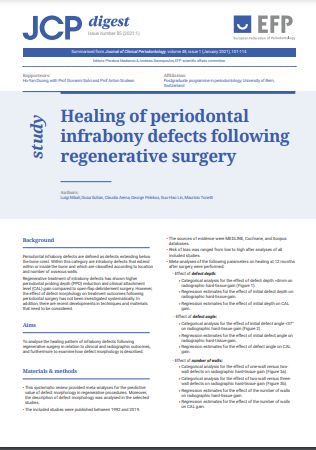![]()
1 June 2021
Defect morphology ‘can help predict outcomes following regenerative surgery’
Categories:Clinical Practice, Communication

The initial morphology of patients with periodontal infrabony defects can be taken as an indicator of likely treatment outcomes of regenerative surgery, according to research summarised in the latest edition of JCP Digest.
Issue number 85 of the EFP’s research summary outlines a systematic review carried out by researchers at universities in London (UK), San Francisco (USA), Foggia (Italy), and Hong Kong which analysed the healing pattern of infrabony defects following regenerative surgery in relation to clinical and radiographic outcomes.
The review focused on outcomes at 12 months, using three parameters: the effect of defect depth, the effect of defect angle, and the effect of the number of walls.
It concluded that, 12 months after regenerative surgery, there were increases in radiographic hard-tissue gain as well as gains in clinical attachment levels (CAL). In addition, deep defects positively influenced hard-tissue gain, while narrow angles and a greater number of walls positively influenced both hard-tissue and CAL gain.
The research was summarised for JCP Digest by a student in the EFP-accredited postgraduate programme in periodontology at the University of Bern in Switzerland.




